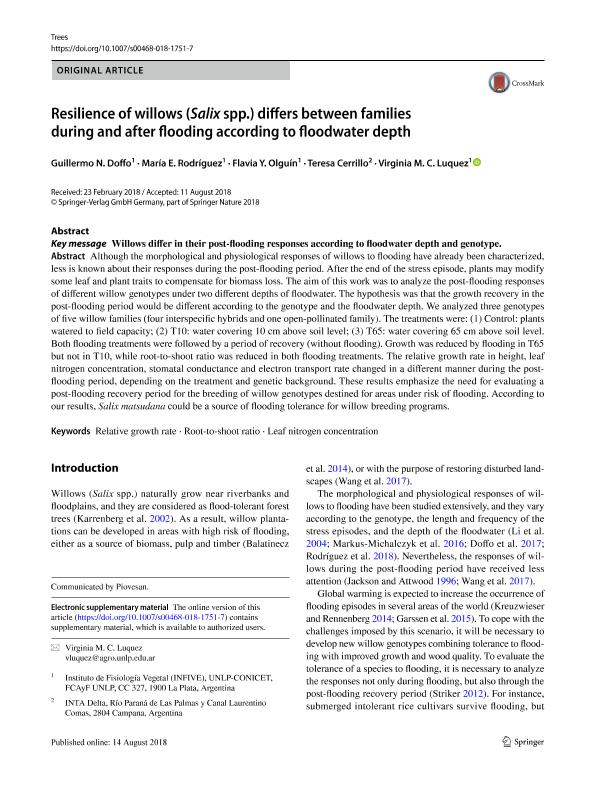Mostrar el registro sencillo del ítem
dc.contributor.author
Doffo, Guillermo Nestor

dc.contributor.author
Rodríguez, María Emilia

dc.contributor.author
Olguin, Flavia Yesica

dc.contributor.author
Cerrillo, Teresa

dc.contributor.author
Luquez, Virginia Martha Cristina

dc.date.available
2020-01-06T20:20:53Z
dc.date.issued
2018-12
dc.identifier.citation
Doffo, Guillermo Nestor; Rodríguez, María Emilia; Olguin, Flavia Yesica; Cerrillo, Teresa; Luquez, Virginia Martha Cristina; Resilience of willows (Salix spp.) differs between families during and after flooding according to floodwater depth; Springer; Trees; 32; 6; 12-2018; 1779-1788
dc.identifier.issn
0931-1890
dc.identifier.uri
http://hdl.handle.net/11336/93704
dc.description.abstract
Willows differ in their post-flooding responses according to floodwater depth and genotype. Abstract: Although the morphological and physiological responses of willows to flooding have already been characterized, less is known about their responses during the post-flooding period. After the end of the stress episode, plants may modify some leaf and plant traits to compensate for biomass loss. The aim of this work was to analyze the post-flooding responses of different willow genotypes under two different depths of floodwater. The hypothesis was that the growth recovery in the post-flooding period would be different according to the genotype and the floodwater depth. We analyzed three genotypes of five willow families (four interspecific hybrids and one open-pollinated family). The treatments were: (1) Control: plants watered to field capacity; (2) T10: water covering 10 cm above soil level; (3) T65: water covering 65 cm above soil level. Both flooding treatments were followed by a period of recovery (without flooding). Growth was reduced by flooding in T65 but not in T10, while root-to-shoot ratio was reduced in both flooding treatments. The relative growth rate in height, leaf nitrogen concentration, stomatal conductance and electron transport rate changed in a different manner during the post-flooding period, depending on the treatment and genetic background. These results emphasize the need for evaluating a post-flooding recovery period for the breeding of willow genotypes destined for areas under risk of flooding. According to our results, Salix matsudana could be a source of flooding tolerance for willow breeding programs.
dc.format
application/pdf
dc.language.iso
eng
dc.publisher
Springer

dc.rights
info:eu-repo/semantics/openAccess
dc.rights
Atribución-NoComercial-CompartirIgual 2.5 Argentina (CC BY-NC-SA 2.5 AR)
dc.rights.uri
https://creativecommons.org/licenses/by-nc-sa/2.5/ar/
dc.subject
LEAF NITROGEN CONCENTRATION
dc.subject
RELATIVE GROWTH RATE
dc.subject
ROOT-TO-SHOOT RATIO
dc.subject.classification
Silvicultura

dc.subject.classification
Agricultura, Silvicultura y Pesca

dc.subject.classification
CIENCIAS AGRÍCOLAS

dc.title
Resilience of willows (Salix spp.) differs between families during and after flooding according to floodwater depth
dc.type
info:eu-repo/semantics/article
dc.type
info:ar-repo/semantics/artículo
dc.type
info:eu-repo/semantics/publishedVersion
dc.date.updated
2019-10-18T18:31:26Z
dc.journal.volume
32
dc.journal.number
6
dc.journal.pagination
1779-1788
dc.journal.pais
Alemania

dc.journal.ciudad
Berlín
dc.description.fil
Fil: Doffo, Guillermo Nestor. Instituto de Fisiología Vegetal, Universidad Nacional de la Plata; Argentina
dc.description.fil
Fil: Rodríguez, María Emilia. Instituto de Fisiología Vegetal, Universidad Nacional de la Plata; Argentina
dc.description.fil
Fil: Olguin, Flavia Yesica. Instituto de Fisiología Vegetal, Universidad Nacional de la Plata; Argentina
dc.description.fil
Fil: Cerrillo, Teresa. Inta Delta; Argentina
dc.description.fil
Fil: Luquez, Virginia Martha Cristina. Instituto de Fisiología Vegetal, Universidad Nacional de la Plata; Argentina
dc.journal.title
Trees

dc.relation.alternativeid
info:eu-repo/semantics/altIdentifier/url/https://link.springer.com/article/10.1007%2Fs00468-018-1751-7
dc.relation.alternativeid
info:eu-repo/semantics/altIdentifier/doi/http://dx.doi.org/10.1007/s00468-018-1751-7
Archivos asociados
